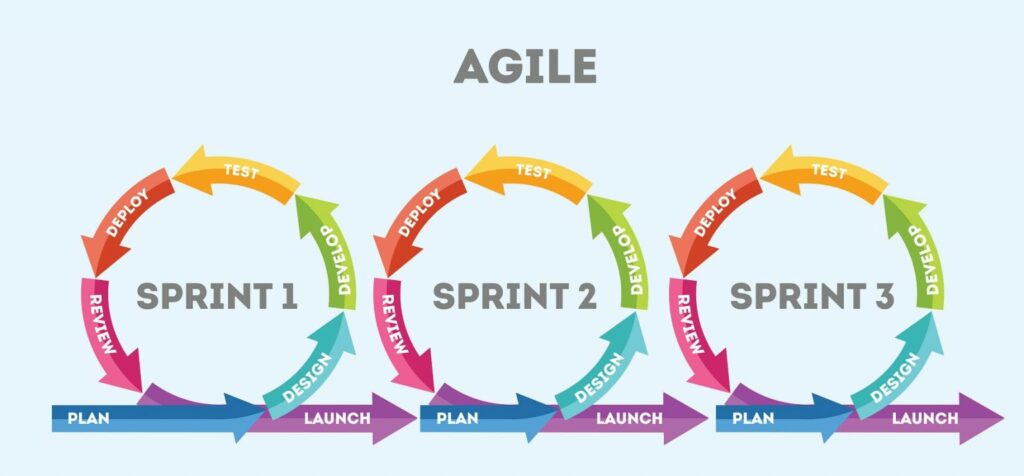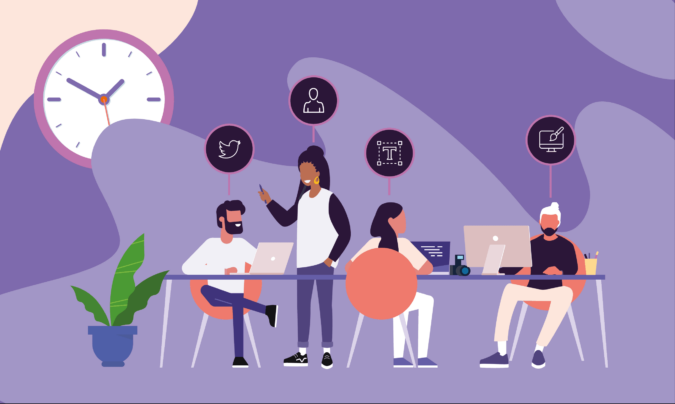“We’re an Agile agency 🚀.”
Buzzword alert.
You probably already know—Agile isn’t just for software developers anymore. Increasingly agencies, consultancies, and other knowledge-based project teams are adopting Agile as their preferred method to deliver projects.
After all, Agile projects deliver proven value in software projects:
- Higher profit
- More meaningful projects and client relationships
- Greater productivity
- Clearer communication
Yet, there’s no cookie-cutter way to be an Agile agency; people even refer to it as a “mindset” rather than a “methodology”.
We’ve separated the truth from the spin so you can figure out:
- What an Agile agency is
- Should you adopt Agile at your agency?
- The challenges when switching to Agile
- The steps to becoming an Agile agency
What is an Agile agency?
An Agile agency uses the Agile methodology to plan, manage, and deliver projects in collaboration with clients.
Traditionally, agencies lean on sequential phases and tasks to deliver a project. On the other hand, an Agile agency focuses on delivering incremental value in each iteration of a project. This way a client sees outcomes right from the first iteration.
What is Agile methodology?

The Agile methodology uses constant iteration and feedback to deliver outcomes collaboratively with the client. According to the Agile Manifesto, this methodology focuses on:
| ✅ Individuals and interactions | ❌ Processes and tools |
| ✅ Working deliverables | ❌ Comprehensive documentation |
| ✅ Customer collaboration | ❌ Contract negotiation |
| ✅ Respond to change | ❌ Set plans |
Traditional project management methods focus on each phase only once during the project’s lifecycle. For example, in Waterfall project management, the phases are:
- Requirement analysis
- Planning
- Execution
- Testing
- Delivery (or Deployment)
Each phase is executed once. And the resulting document is passed off to the next phase and team. There’s no way a client can get their hands on a working deliverable right until the end. As a result, accommodating change requests become extremely hard.
In Agile, a project is broken down into 2-4 week iterations. In each iteration, the project team delivers a working part of a project to the client. This implies that in each iteration, the team goes through planning, execution, testing, and delivery phases to deliver a working iteration of the project.
Agile methodology example
Let’s break down the Agile methodology using a typical agency example—building a website:
| Designing a 10-page website | Agile methodology | Traditional or Waterfall methodology |
|---|---|---|
| Gather website requirements | A scoping session at the start followed by detailed scope definitions for each iteration | One workshop with the client at the start to gather all requirements |
| Plan page development schedule | A high-level roadmap and detailed iteration planning allow for faster adjustments | Planning the entire project schedule at once results in rigid schedules |
| Design and develop website pages | Uses open-sharing design tools so the client can see what’s being built. | Takes place “behind closed doors” and is closely based on original specs. |
| Get client feedback and approval | Live wireframing sessions enable the client to provide feedback during development, weekly discussions, and reports to share progress. | Only takes place once each page or the whole website has been built. |
| Scope changes | Can happen on the go, and the team can respond to changes without losing too much time. | Require new scoping exercises, timeline extensions, and additional resources. |
| Launch | Pages delivered at the end of each iteration can be launched after approval. | Only happens when the whole 10 pages are completed and signed off. |
Why should you adopt Agile in your agency?
Here are four reasons why Agile might be your agency’s catalyst for success (and bear in mind that these benefits all feed into each other):
Accommodate ever-changing client expectations
Close to half the projects experience scope creep.
And sometimes changes are part of the project landscape and cannot be avoided.
For example, marketing agencies often have to accommodate change requests as trends change. Agile project management in marketing helps easily absorb these changes.
Here’s how:
- Weekly feedback sessions so teams can apply changes without being held back
- Open access to documents so clients can see work-in-progress (it doesn’t have to be perfect)
- Shift focus away from set-in-stone specifications and onto making progress quickly
- Where possible, enable project phases to start simultaneously—for example, copywriters can start writing the landing page while developers finalize the design
Helps you stay profitable
You may think that nailing down project specifications early on is the best way to control costs and budgets.
But Waterfall projects fail to accommodate and control the major problems affecting your bottom line. For example, rework or lack of team productivity.
Shifting to Agile has helped 60% of companies see higher profits thanks to:
- More frequent and integrated client feedback—weekly reviews and live feedback sessions enable agency teams to respond quickly and collaborate effectively with clients. Changes are less likely to be dramatic and render months of work a complete waste of time.
- Bite-sized sprints that are time-tracked—sprints give agencies greater visibility and control over their resources. Issues like scope creep and unproductive team members can be identified and dealt with quickly.
Attracts and retains the best talent
Agencies are plagued by two expensive HR issues—burnout and turnover.
- Employee stress and burnout cost US businesses over $300 billion per year
- And hiring a replacement can cost up to 60% of the employee’s salary
These problems are soul-crushing for everyone. And remote work often compounds these problems.
An Agile mindset is a powerful layer of protection against these issues.
- 2-4 week iterations ensure that no one is overworked
- Agile’s focus on communication and collaboration encourages and facilitates working in a team
It’s important to remember that your agency processes become your greatest selling point as an employer.
Enhances creativity
When you’re leading an agency providing marketing, web development, branding, or software engineering—your success is defined by creativity. You started out because you love doing good work and creating beautiful things—and you’ve built a team of people who share that ethos.
Unlike traditional methods, Agile focuses on individuals over processes and working deliverables over documentation. As a result, team members feel empowered to take creative decisions.
Challenges of switching to Agile
Becoming an Agile agency is not an overnight process. It takes time, flexibility, and a few mistakes before your business, your team, and your clients get used to it.
These are the four most common roadblocks to prepare for:
Figuring out what Agile looks like for your agency
Agile is fairly flexible and can be adapted to any project.
It’s critical to figure out what being Agile project management means to your agency or consultancy. You may want to ask these questions:
- What is the outcome we deliver at the end of an iteration?
- How long should an iteration be to plan, execute, measure, and report on this outcome?
- What roles are needed in each iteration?
- Scrum vs. Kanban—what’s a better Agile method for us?
- How do we get feedback and approvals from clients?
Agile is a great hammer, but that doesn’t mean every agency process is a nail.
Educating your team on Agile practices
Switching to Agile may seem like a huge leap for your team.
Agile’s success is widely documented, but it’s still a complex and technical methodology to get your head around.
Ultimately, Agile agencies need to invest in educating and supporting their staff alongside ensuring they have enough time and mental space to complete their BAU tasks.
Investing in Agile project management tools
Transitioning from traditional Waterfall to Agile agency processes may require a new tech stack.
For example, because Agile emphasizes internal and external collaboration and feedback, you may need to invest in tools with:
- Meeting tools with screen-sharing functions
- Project management tools with Agile planning features like kanbans, product backlogs, sprints, and daily stand-ups
- Time-tracking capability to measure and track progress, productivity, and resources
This is exciting, but also potentially expensive, especially if you have to try and test a few tools at the beginning.
Getting buy-in from clients
Lastly, but perhaps most importantly, you need clients to support your journey into the world of Agile.
Without a careful explanation of what Agile looks like and how it changes the status quo, clients might rush to assumptions that:
- You’re looking for a way to increase prices
- They have to invest too much time in feedback sessions
- Project deliverables are unstable and unclear
And if they’re not on board, they’ll walk away.
How to become an Agile agency
We’ve broken it down into seven steps:
| Step | Summary |
|---|---|
| 1. Start small | Start with your most long-term and trusted client—and your most straightforward but least mission-critical process. |
| 2. Learn the terminology | Create an Agile glossary and share it with the team. |
| 3. Understand Agile roles | Learn about Product Owner, Scrum Master, and Team member roles and what they’ll look like for your agency. |
| 4. Learn to work in Sprints | Deliver the project outcomes into sprints, use your PM tools and daily meetings to get the work done, and constantly iterate. |
| 5. Establish a culture of open communication | Focus on being clear, brief, and ‘showing’ progress. |
| 6. Invest in the right tools | Build a tech stack of PM tools that include Agile-specific features like Kanban boards, Scrum boards, and time tracking. |
| 7. Feedback, iterate, repeat until you get there | Build your Agile processes around regular, specific feedback within your internal team and with the client—so you can constantly improve. |
1. Start small
It’s not going to work if you try to change everything all at once, or try to transform all your client-facing processes overnight.
Your best bet is to start small, ask for feedback, iterate as you go, and document the result.
You know… apply an Agile approach to it 😉.
It’s best to start with:
- Your longest-standing client or the strongest relationship: they’ve been with you since the beginning, and you’re well accustomed to their needs, communication style, and expectations. If it goes wrong, they have the most capacity for patience so you can make it right. You trust each other.
- An internal process that’s easy to follow but not mission-critical: everyone in your team understands the process inside out, but it’s not a fundamental part of your agency workflow. You have room to tinker with it while continuing BAU, and you can roll it out in tandem with your old process to see how well it works.
If you go big from the start, you risk getting it wrong on a large scale, which could jeopardize your much-needed client and team buy-in.
By aiming for small wins in areas that are easy to explain and document, you build an arsenal of success stories to use throughout your internal team and to the clients who are more conservative and risk-averse.
2. Build a glossary of terms
Take the time to clarify the Agile terminology to your team and your clients by building a glossary of terms, with the context of how they fit within your agency frameworks.
Here’s how you can implement the glossary, so it’s as engaging, relevant, and accessible as possible:
- Ensure that all team members have access to the glossary—suggest that they bookmark it on their desktop, or produce a printable version for them to keep on their desks.
- When implementing the glossary into your digital processes, use the old terminology in explanations for context—your team shouldn’t feel like they’re being tested when they’re just trying to do their job.
- Run short workshops or meetings where your team can ask questions or gain more context into what the new terminology means and how to implement it into their role.
3. Understand Agile roles
The wild thing about Agile is that it has thrown a lot of traditional agency roles out the window.
Agile roles focus on cross-functional expertise. Teams have a holistic focus so that they can be put on any project and deliver high-quality results quickly, institutional knowledge isn’t trapped within your people.
Let’s break it down:
| Traditional role | Agile role | Responsibility |
|---|---|---|
| Client/Account manager | Product Owner |
|
| Project manager/Team lead | Scrum Master |
|
| Team | Team (designer, writer, engineer, SEO, trader) |
|
4. Learn to work in Sprints
Agile projects are executed in iterations—also known as Sprints.
A Sprint is a single period of time to deliver a working outcome to the client. Usually, a sprint is 2-4 weeks. But depending on the work involved it could also be less or more.
Here’s what a typical Sprint looks like:
Before the Sprint
First, the product owner chooses things to work on during a Sprint from the project backlog. A backlog is a prioritized list of project outcomes.
Next, the scrum master along with the team breakdown the chosen outcomes into tasks. They also assign estimates to each task. Depending on the estimates and the time available some of the outcomes may go back to the project backlog.
Finally, the team and product owner agree and commit to the outcomes of a Sprint.
During the Sprint
The team uses a Kanban board or a Scrum board to track the progress of each task.
Every morning, the team comes in a stand-up meeting (15-minute meeting where everyone is literally standing up) together to discuss:
- What did we do yesterday?
- Are there any roadblocks or challenges?
- What are we doing today?
As the tasks get done, team members responsible move the task cards on the board from “To do” to “Done”
After the Sprint
The entire team along with the product meets for a retrospective meeting.
During the retrospective meeting, the team discusses what went well and what didn’t during the last Sprint. Learnings are noted down and used to improve future Sprints.
5. Build an open and transparent team communication culture
Well-implemented Agile communication:
- Ensures everyone is on the same page
- Tackles challenges and roadblocks quickly
- Helps you gain more insight from the people closest to the deliverable
- Passes more relevant and accurate information between team members and clients
This is about building your processes around the meetings including:
- Sprint planning meeting
- Daily standup meeting
- Retrospective meeting
The approach to Agile comms is simple: Show the thing, be clear, and be brief.
6. Choose the right PM tools
As an Agile agency, your project management tools should be built around your people and their processes—not the other way around!
To successfully implement and see the most value from Agile frameworks, look for these features in your project management tech stack:
- Kanban boards
- Project backlogs
- Task scheduling
- Time tracking
- Progress visualization
Choosing the right project management software ensures that your teams are empowered to be productive, creative, collaborative, and effective.
7. Ask for feedback, learn, rinse, and repeat
Feedback is the secret to Agile’s success.
Not just by increasing the amount of feedback from the client, but also by constantly gathering it from all areas of your team.
As you restructure your agency processes to become more Agile, build feedback within each phase so that after every Sprint is complete, people have the opportunity to reflect on:
- What went well
- What didn’t go so well
- Opportunities and ideas to improve
It’s important to build a process around documentation so that all feedback is written down, stored in an organized way, and easily accessible for future reference.
As an agency owner, this part of the process is the most rewarding because you get to learn exactly how to improve your business, make it more profitable, and ensure that it’s a great place to work.
The insights gained from your team and your clients can quickly become the messages you use to attract top talent and win future clients.
Becoming an Agile agency requires an Agile approach
Agile can be a catalyst for growth and success for your agency if you invest the time and energy into educating your team, supporting your clients, and discovering what processes truly help your business.
The key is to take it slow, keep talking to your team and your clients, and be honest about the results.
Jitesh is an SEO and content specialist. He manages content projects at Toggl and loves sharing actionable tips to deliver projects profitably.


